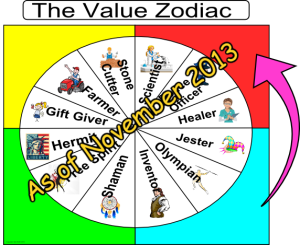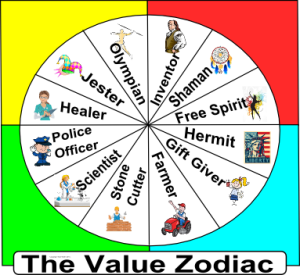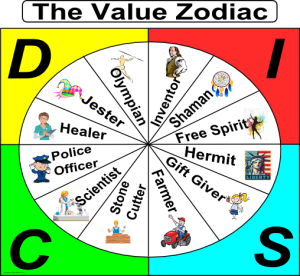In the past several weeks, there has been some exciting development of the Value Zodiac. The Value Zodiac was initially developed in spring of this year. At the time, the model was divided into four quadrants in part to give the model of visual appeal, but there was some suspicion that the quadrants could be more significant. 
Last month there was a breakthrough. The model was not oriented correctly. The figure right shows the original model. The new insight came about when the model was turned a few notches. 
Let’s analyze the revised model by the quadrant. The bottom-left quadrant is made up of people who are big on policies and procedures. They are more comfortable with precedent and tried and true methods. They also value hard data. The bottom-right quadrant is composed of people who are humble and work to make others feel comfortable. They have no need for the limelight and largely want to work quietly and independently. They see no need in trying to wield power over others. The upper-right quadrant is comprised of people who like to have fun, who are very creative, and seek truth from intuition and less data driven sources. Finally, the upper-left quadrant is made of of highly competitive folks, people who believe in getting everyone involved in solutions to problems–leadership, and those who are masters of persuasion and messaging.
Organizational development professionals and leadership training professionals may notice echos of another leadership model here. It’s the DISC model.  One of the biggest criticisms of DISC(R) is the fact that two individuals have an identical DISC score but have very different performance levels and professional outcomes for the same position. The Value Zodiac provides an explanatory framework for this phenomenon. The problem with DISC is that it lacks precision. The Value Zodiac is three times more precise than DISC. As such, it provides a much greater explanatory framework of human motivation.
One of the biggest criticisms of DISC(R) is the fact that two individuals have an identical DISC score but have very different performance levels and professional outcomes for the same position. The Value Zodiac provides an explanatory framework for this phenomenon. The problem with DISC is that it lacks precision. The Value Zodiac is three times more precise than DISC. As such, it provides a much greater explanatory framework of human motivation.
Perhaps one of the greatest strengths of the Value Zodiac is the fact that unlike most other personality assessments, it was not developed empirically, but theoretically. Recall that the model was not developed to make sense of data, the model was developed first to evaluate personal values. Therefore, if the theory holds, it provides a much better explanatory framework of human motivation than a construct developed merely to explain data.
The Value Zodiac derives DISC. As a man of science, I don’t use that term lightly. For this reason and others, the Value Zodiac is a powerful tool, as valid as DISC, but with much greater managerial utility.
